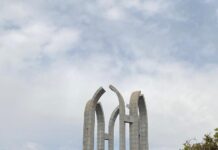It’s hard to imagine that barely three weeks ago, most of Afghanistan was under the control of the Columbia University-trained President Mohammad Ashraf Ghani. Following the withdrawal of US-military troops, province after province, the country’s military defence crumbled like a pack of cards and by Sunday, August 15th, Taliban fighters were seen sitting at the Presidential palace in Kabul and reciting the Koran, as the embattled President fled his country. India’s former Ambassador to Kabul, Gautam Mukhopadhaya, described the Taliban takeover as a “Pakistani invasion with an Afghan face”. He was not totally wrong.
As the war against the Soviet-backed communist government in Afghanistan raged on between December 1979 – February 1989, Pakistan, her neighbour in the eastern and southern borders had a mix of concerns and aspirations of her own. First, the influx of Afghan refugees into the country since the early eighties has resulted in an increased incidence of drug trafficking, organized crime, terrorism as well as caused an upstick in sectarian violence.
Perpetually at conflict with India, Pakistan’s Afghan frontier is of strategic military importance and both the Pakistan army and ISI are willing to leverage on that. An Afghan government closely aligned with Karachi will not only provide Pakistan with a base to pursue its territorial interests in Kashmir and ensure greater security against India but also provide the former with stronger political and economic links to Central Asia. But there is more to it and has to do with the nuclear-armed country’s internal struggles as a nation.
Pashtuns are the largest ethnic group in Afghanistan, constituting about half of the country’s 33 million population and the second-largest ethnic group in Pakistan after the Punjabis. Pashtun nationalism, long considered a threat to Pakistani’s corporate existence, sought to carve out an independent Pashtun state from Pakistani and Afghan territories.
The Pashtunistan movement picked up steam in the early 1970s and this was around the time, Baloch nationalists managed to form a government in Balochistan and so the Pashtun issue was starting to look like an existential threat to the nation. It was at that stage that Pakistan started courting Islamists in Afghanistan.
Pakistan’s first move was to pitch tent with Gulbuddin Hikmatyar’s Hezb-e-Islami, a Pashtun-dominated group that espoused an Islamist rather than nationalist agenda, during the Soviet-Afghan War. Hikmatyar’s failure to defeat the Afghan government forces under the command of Defense Minister, Ahmad Shah Massoud, however, dealt a serious blow on Pakistan’s Afghan policy and left her intelligence agency, ISI searching for a new partner. Enter the Taliban.
In September 1994, Mullah Mohammad Omar, an Afghan mujahid commander in the war against Soviet occupation and an influential cleric with a group of 50 Islamic students comprising mostly ethnic Pashtuns, founded a movement in his hometown of Kandahar. They referred to themselves as the Taliban, which in their native Pashto language, means means ”Students” or ” Seekers”.
Mullah Omar was unhappy that even after the Soviet-backed communist government ouster, secular laws continued to rule the land in Afghanistan. He pledged to rid Afghanistan of warlords and criminals and establish an Islamic Emirate that will enforce strict adherence to Sharia law.
For Pakistan, it was comforting to know that the Deoband school to which the Taliban belong, are ideologically opposed to dividing Islam on the basis of national boundaries. This means that Pashtun nationalists in Pakistan will have no backing from the Taliban in Afghanistan and as such was seen as an effective strategy to counter ethnic nationalism and solve the nation’s Pashtun problem. Within a few months, thousands of students from religious schools known as madrasas signed up and would later become a very strong and committed fighting force.
Of all the foreign powers involved in the formation and providing operational support for the Taliban, nothing compares in scope to Pakistan’s expansive activities. They offered logistic support and training for Taliban fighters and provided them with a safe haven. They helped the group plan and execute major military operations while private-sector actors especially in the Pashtun-dominated tribal areas provide financial assistance to the Taliban.
Human Rights Watch source reported that as far back as April and May of 2001, a convoy of trucks, most times numbering up to thirty with some carrying shells, RPG’s, tank rounds and artillery shells were seen daily crossing the Pakistan border for delivery to Afghanistan. The Siamese twins of the Pakistani army and the Pakistani Inter-Services Intelligence Directorate (ISI) were largely responsible for transforming a ragtag army of Islamic students called the Taliban, into an effective fighting force.
In an effort to support the anti-Soviet insurgency in the 1980s, America’s CIA through the United States Agency for International Development (NSAID), covertly provided millions in aid to the Taliban and helped develop and publish the movement’s pieces of literature in local languages. Most of those American dollars were channelled through the Pakistan Intelligence Agency, ISI. Such was the intricate web of relationships that existed between the Taliban, Pakistan and the United States before the 9/11 terror attack on America.
With the reversal of America’s policy towards the Taliban in the aftermath of the 9/11 attack, Pakistan started to play a role that could only be described as an equivalent of a double agent. She claimed to aid the United States in its war on terror, raking in billions of dollars in aid, even as the political leadership of the Taliban camped in the Balochistan capital of Quetta and both South and North Waziristan regularly churns out scores of hardened Taliban fighters. The US was well aware of the existence of these safe havens within Pakistan but needed Pakistan to prosecute the war in Afghanistan and so couldn’t punish her for the sabotage. There were also many other instances of US administration assisting Pakistan to actively undermine its effort. Take, for instance, the issue of the Kunduz airlift of November 2001.
When the capture of Kunduz, the largest city in northeastern Afghanistan by the US and United Front troops became imminent, President Pervez Musharraf requested and got permission from President Bush to evacuate thousands of top commanders and regular fighters of the Taliban and Al-Qaeda, Pakistani Inter-Services Intelligence agents and military personnel, as well as volunteers. Musharraf feared that the killings of Pakistanis in Kunduz could lead to unrest and instability in his country. If the move sounds counterintuitive to the US effort, it is because it is. For those that believe and often talk about the US military-industrial complex, there was no other way to spin it around. Or how else to explain that a country that heavily mobilized to fight a vicious enemy, would provide that same enemy with an easy escape route.
An estimated 3-5000 battle-hardened Taliban and Al Qeida fighters were allegedly evacuated using a Parkistan Air Force cargo aircraft to their bases in Chitral and Gilgit in the Pakistan-administered Kashmir’s Northern areas. This was dubbed by the American press as the Airlift of Evil. The justification for the operation was that Pakistan had many military and intelligence officers fighting with the Taliban, and feared for their safety after Kunduz fell. As expected, this was a contentious political issue in the United States and with America’s NATO allies but of course, the Bush administration denied that such ever happened.
As the war lasted from year to year, it became clear that any meaningful attempt at peace is untenable without the Taliban at the table. Taliban leader, Mullah Abdul Ghani Baradar who until then was serving jail term in Pakistani prison since 2010 was released at the request of the Trump administration and tipped to lead the Taliban side of the talks in 2018. The Doha peace deal signed in February 2020, promised that the US and its NATO allies would withdraw all troops in 14 months if the Taliban upheld its promises, including not allowing al-Qaeda or other militants to operate in areas it controlled.
A prior attempt by Mullah Barada to engage former President Karzai’s government through a backchannel in the past was frustrated by Pakistan. Pakistani authorities made it clear to the Taliban that they wanted to be at the driver seat of any deal to be made.
It is curiously perplexing to note that Afghan government officials were never invited during the talk with the Talibans. This may be due to the mistrust of US administrations with successive Afghan governments dating back to the time of President Hamid Kharzai. All US Presidents from Bush to Obama and now Biden questioned Afghan leader’s commitment to form an inclusive government not bedevilled by nepotism and large scale corruption. On March 24th, 2020, the US Embassy in Kabul released a statement that read; ”The United States is not abandoning our partnership with Afghanistan, nor our commitment to support the Afghan security forces, but reviewing the scope of our cooperation given the irresponsible actions of Afghan leaders.”
Perhaps the former Indian ambassador’s words captured the mood of the ousted President and his Afghan National Defence and Security Forces and explain one of the reasons they didn’t feel the need to fight. But that would be a lousy excuse that ignores every other daunting challenge that confronted the deposed political leadership. One would have expected the Afghan military to mount even a modicum of resistance but instead, the Taliban cruised in victory, all the way to Kabul. This was after the United States wasted twenty years and spent a whopping $89 billion to train and equip the force. As we have come to learn, President Ghani’s government was fighting many demons simultaneously.
Factors ranging from weak, ineffectual and purposeless leadership that made commanders and troops lose faith in Kabul have all been adduced to explain why Afghan soldiers collapsed so quickly in the face of the Taliban advance. Corruption was reported to have become so rampant to the extent that it affected soldier’s compensation and invariably the morale. Unlike the Taliban who are united by a militant Islamist ideology, the Afghan army were mostly populated by those whose motivation were to have a job rather than a commitment to serve and protect their country. The return of the Talibans is unfortunate, to say the least, but ultimately, every nation including Afghanistan gets the kind of leadership it deserves.
Dr Agbo, a Public Affairs analyst is the coordinator of African Center for Transparency and Convener of Save Nigeria Project. Email: Eagleosmund@yahoo.com
Follow the Neptune Prime channel on WhatsApp:
Do you have breaking news, interview request, opinion, suggestion, or want your event covered? Email us at neptuneprime2233@gmail.com





